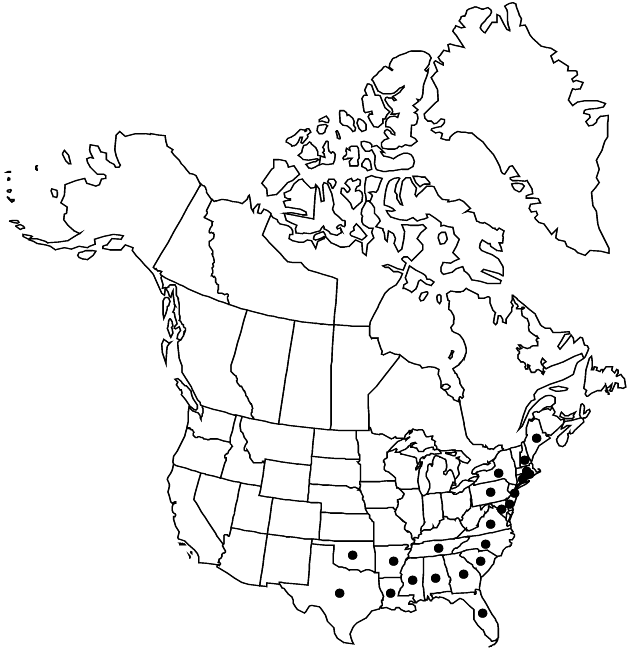Difference between revisions of "Cirsium horridulum"
Fl. Bor.-Amer. 2: 90. 1803.
FNA>Volume Importer |
RevisionBot (talk | contribs) m (Bot: Adding category Revised Since Print) |
||
| (5 intermediate revisions by 3 users not shown) | |||
| Line 8: | Line 8: | ||
}} | }} | ||
|common_names=Bristly or horrid or yellow or bull thistle | |common_names=Bristly or horrid or yellow or bull thistle | ||
| + | |special_status={{Treatment/ID/Special_status | ||
| + | |code=F | ||
| + | |label=Illustrated | ||
| + | }} | ||
|basionyms= | |basionyms= | ||
|synonyms= | |synonyms= | ||
| Line 20: | Line 24: | ||
-->{{Treatment/Body | -->{{Treatment/Body | ||
| − | |distribution= | + | |distribution=Ala.;Ark.;Conn.;Del.;Fla.;Ga.;La.;Maine;Mass.;Md.;Miss.;N.C.;N.H.;N.J.;N.Y.;Okla.;Pa.;R.I.;S.C.;Tenn.;Tex.;Va.;Mexico. |
|discussion=<p>Varieties 4 (3 in the flora).</p><!-- | |discussion=<p>Varieties 4 (3 in the flora).</p><!-- | ||
--><p>Although several variants have been given taxonomic recognition as species, these seem at most races. Flower color varies greatly, sometimes within populations and sometimes on a populational or regional basis. Herbarium specimens are sometimes difficult to assign to variety.</p> | --><p>Although several variants have been given taxonomic recognition as species, these seem at most races. Flower color varies greatly, sometimes within populations and sometimes on a populational or regional basis. Herbarium specimens are sometimes difficult to assign to variety.</p> | ||
| Line 53: | Line 57: | ||
-->{{#Taxon: | -->{{#Taxon: | ||
name=Cirsium horridulum | name=Cirsium horridulum | ||
| − | |||
|authority=Michaux | |authority=Michaux | ||
|rank=species | |rank=species | ||
| Line 60: | Line 63: | ||
|basionyms= | |basionyms= | ||
|family=Asteraceae | |family=Asteraceae | ||
| − | |distribution= | + | |distribution=Ala.;Ark.;Conn.;Del.;Fla.;Ga.;La.;Maine;Mass.;Md.;Miss.;N.C.;N.H.;N.J.;N.Y.;Okla.;Pa.;R.I.;S.C.;Tenn.;Tex.;Va.;Mexico. |
|reference=None | |reference=None | ||
|publication title=Fl. Bor.-Amer. | |publication title=Fl. Bor.-Amer. | ||
|publication year=1803 | |publication year=1803 | ||
| − | |special status= | + | |special status=Illustrated |
| − | |source xml=https:// | + | |source xml=https://bitbucket.org/aafc-mbb/fna-data-curation/src/2e0870ddd59836b60bcf96646a41e87ea5a5943a/coarse_grained_fna_xml/V19-20-21/V19_62.xml |
|tribe=Asteraceae tribe Cardueae | |tribe=Asteraceae tribe Cardueae | ||
|genus=Cirsium | |genus=Cirsium | ||
| Line 71: | Line 74: | ||
}}<!-- | }}<!-- | ||
| − | -->[[Category:Treatment]][[Category:Cirsium]] | + | --> |
| + | |||
| + | [[Category:Treatment]] | ||
| + | [[Category:Cirsium]] | ||
| + | [[Category:Revised Since Print]] | ||
Latest revision as of 18:29, 6 November 2020
Biennials or perennials, (± fleshy), 15–250 cm; stout taproots and a fascicle of fleshy lateral roots, often perennating by root sprouts. Stems 1–several, usually erect, often stout, glabrous to densely tomentose; branches 0–many, spreading to ascending, short, stout. Leaves: blades linear to oblanceolate or oblong-elliptic, 10–40 × 2–10 cm, unlobed and spiny-dentate to deeply pinnatifid, lobes spiny-dentate or coarsely lobed, main spines stout, 5–30 mm, abaxial faces subglabrous to loosely tomentose, adaxial glabrous to ± densely villous with septate trichomes; basal present at flowering, spiny winged-petiolate, bases often tapered; principal cauline sessile, well distributed, often not much reduced distally, bases often ± auriculate-clasping; distal cauline often spinier than the proximal. Heads 1–20 in subcapitate to corymbiform arrays (each closely subtended by an involucre-like ring of spiny-margined bracts). Peduncles 0–5 cm. Involucres hemispheric to campanulate, 3–5 × 3–8 cm. Phyllaries in 5–9 series, subequal to imbricate, light green to stramineous, lanceolate to linear, distally often with reddish margins, abaxial faces without glutinous ridge, often ± thinly tomentose, often scabridulous in submarginal bands; outer and middle appressed-ascending, bodies usually reddish-tinged, margins setulose-ciliolate, apices acuminate, spines 1–2 mm, weak; apices of inner straight, flat. Corollas white to yellow, pink, purple, or red, 30–47 mm, tubes 11–30 mm, throats 6–10 mm, lobes 7–10 mm; style tips 3–5 mm. Cypselae straw-colored to tan, 4–6 mm, apical collars weakly differentiated; pappi 25–35 mm. 2n = 32, 33, 34, 35.
Distribution

Ala., Ark., Conn., Del., Fla., Ga., La., Maine, Mass., Md., Miss., N.C., N.H., N.J., N.Y., Okla., Pa., R.I., S.C., Tenn., Tex., Va., Mexico.
Discussion
Varieties 4 (3 in the flora).
Although several variants have been given taxonomic recognition as species, these seem at most races. Flower color varies greatly, sometimes within populations and sometimes on a populational or regional basis. Herbarium specimens are sometimes difficult to assign to variety.
Selected References
None.
Lower Taxa
Key
| 1 | Stems densely tomentose; involucres ± densely tomentose | Cirsium horridulum var. horridulum |
| 1 | Stems glabrous or sparsely tomentose; involucres glabrous | > 2 |
| 2 | Leaves shallowly to deeply pinnatifid, main spines 10–30 mm | Cirsium horridulum var. megacanthum |
| 2 | Leaves spinose-dentate to shallowly pinnatifid, main spines mostly 5–10 mm | Cirsium horridulum var. vittatum |